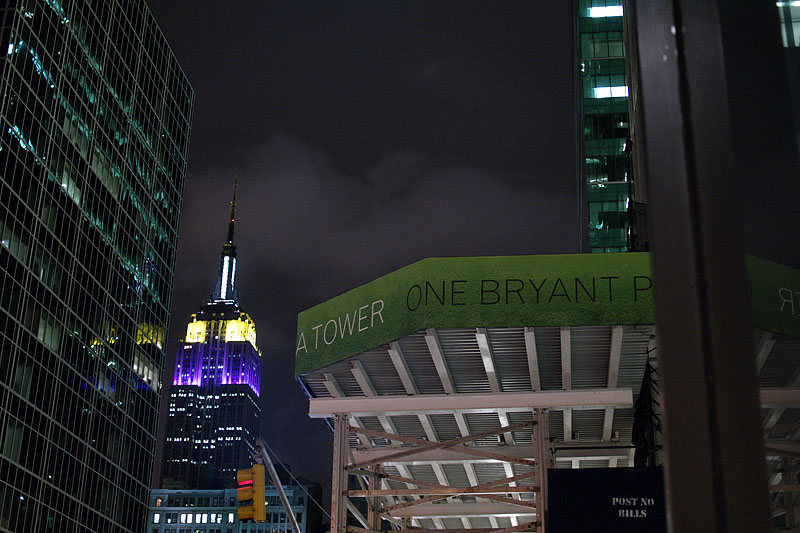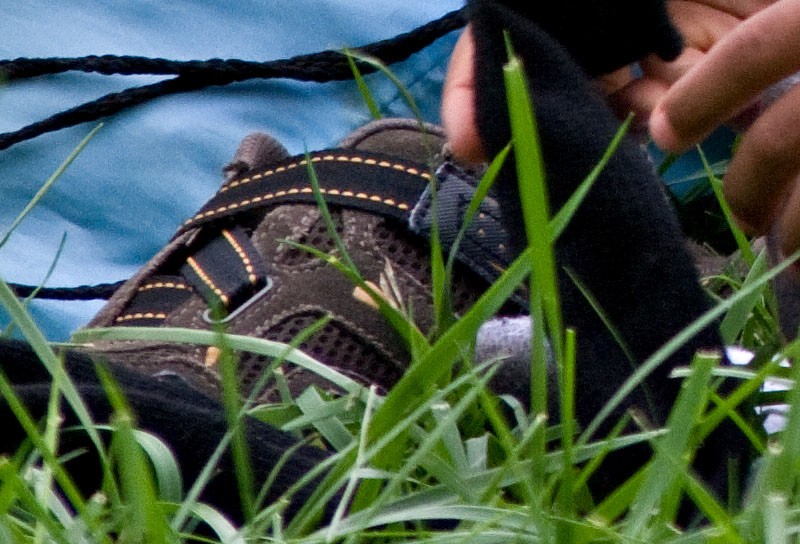Part I is here.
Part III is here.
By Gordon Lewis
Getting Acquainted
One of the major challenges of reviewing any DSLR these days is simply getting familiar with what it can do. Consider the fact that the Pentax K-7’s operating manual measures 14 x 19.5 x 1.5 cm (approximately 5" x 7" x 1/2") and has 328 pages, all in English. I’ve read novels with fewer pages than this. To think that anyone could read every page and absorb every iota of information, along with every possible permutation and then test every feature is, shall we say, unrealistic.
So let me state outright that I’m still getting familiar with the K-7. As evidenced by its manual, there’s plenty to get familiar with. The following is a list of discoveries I’ve had in the course of shooting with the K-7, with an emphasis on which I think are most pertinent to the K-7's suitability as a tool for advanced photographers.
 Empire State Building. This was shot from the corner of 43th Street and Avenue of the Americas. I used the Pentax 35mm ƒ/2.8 Macro with the camera set to ISO 800, 1/10 second at ƒ/2.8, automatic white balance. (Is digital noise clearly visible in the dark tones when this image viewed at 100 percent? Yes. Do I care when the tones are as nicely balanced as this? No.)
Empire State Building. This was shot from the corner of 43th Street and Avenue of the Americas. I used the Pentax 35mm ƒ/2.8 Macro with the camera set to ISO 800, 1/10 second at ƒ/2.8, automatic white balance. (Is digital noise clearly visible in the dark tones when this image viewed at 100 percent? Yes. Do I care when the tones are as nicely balanced as this? No.)Focus
A camera with limited ability to focus quickly and accurately is no fun at all. I’m happy to say that the K-7's autofocus is impressively quick and accurate even in low light. Of course, like any automated system it has its limitations. As I got to know where it excelled and where it struggled, I learned when I could shoot with complete confidence and when I had to lend a helping hand. Fortunately, the latter moments were infrequent and relatively easy to compensate for.
Let’s start with the basics: The K-7 has 11 autofocus points. Nine have cross-sensors and are arranged in a 3x3 rectangle in the center of the viewfinder. The other two are "wide-area" sensors and are to the left and right of the center rectangle. Together they cover enough area that you can focus most off-center subjects without having to shift the frame. This doesn’t mean the K-7 always knows exactly what it is you’re trying to focus on. Like any automated system it will occasionally focus on the foreground when you want to focus on the background and vice-versa. In these situations the answer is to select a single focus point and place it over your subject.
It's easy to see what's going on. The viewfinder magnification is a comfortable .92X. The K-7 is also one of the few cameras in this price range that has a 100% viewfinder, so what you see is exactly what you get. When the K-7 is in its default mode the active AF point will flash in red for a half-second or so to indicate where the camera is focusing. Better yet, the focusing screen is not only bright but "snappy." In good light it’s possible to see for yourself whether the image is in focus or not. This doesn't mean the K-7’s focusing screen is ideal for manual focus, but at least it's usable, which is rare with most DSLRs.
When I combined manual focus with the K-7’s electronic focusing aids I could get consistently sharp results. This is a boon for photographers who want to use older, manual-focus Pentax lenses. (And speaking of manual focus, the focusing rings on the two prime AF lenses I was using were uncommonly smooth and well-damped. Even the focusing ring on the zoom was decent.) Manual focus is by no means as fast as the K-7's AF system and I certainly wouldn't want to use it with fast-moving subjects. That said, it's no slower or less accurate than using a split-image rangefinder or microprism and it allows you to use manual focus lenses that would otherwise be gathering dust on a shelf.
When it came to low-light, I had little trouble achieving accurate focus even with the 55–300mm ƒ/4–5.8 zoom I was using. In general, I found that the K-7 was a second or so slower than the EOS 30D I normally use but more consistently accurate. This was only in low light, however. In medium-to-bright light there was no noticeable difference.
The one area where I did notice a significant difference was in the movement of the focusing ring. Most (but not all) Pentax lens focusing mechanisms are driven by a motor in the body. This means that the focusing ring will turn during autofocus and that you’ll hear a whirring sound until the lens locks focus. The movement and the noise weren’t as annoying as I thought they’d be—I seldom need to operate in stealth mode—but given a choice I’d prefer quieter focusing mechanisms with no external movement. Fortunately, Pentax does offer a choice: All six of their premium DA-Star lenses and one of their DA zooms (the 17–70mm ƒ/4) have Pentax’s Supersonic Drive Motor (SDM) built into the lens instead of the body. SDM lenses focus quietly and the focusing ring stays still during AF.
Exposure
Left to its own devices, the K-7’s multi-segment metering system will rarely blow out highlights. If anything, it tends to underexpose by a third of a stop or so. This is good news for JPEG shooters because although it’s easy to lighten an image by a third of a stop, there’s no way to regain lost highlight detail. Raw shooters who believe in "exposing to the right" can use exposure compensation to dial in an extra third as they see fit. By default the multi-segment metering sets its exposures independently of the focusing point, but you have the option to link it to focus points if you prefer. The K-7 also provides center-weighted and spot metering, each accessible via a small lever located under the exposure mode dial on the top left of the camera.
Do you prefer to separate AF actuation from the shutter button? No problem, the K-7 provides an independent AF button on the back of the camera. Do you prefer having a separate button for locking in an exposure reading? The K-7 has an AE-lock button as well. If, like me, you prefer to shoot JPEGs and to switch to raw only when necessary, Pentax even provides a RAW button accessible to the left thumb. Press it in and you’re instantly in raw mode.
 This was shot handheld with the Pentax 55–300mm ƒ/4-5.8 set to 135mm
(200mm-e). The camera was set to ISO 400, 1/160 second at ƒ/5.6,
automatic white balance. This is a straight JPEG, reduced in size for
the web. It looks flat because it was shot on an overcast afternoon.
This was shot handheld with the Pentax 55–300mm ƒ/4-5.8 set to 135mm
(200mm-e). The camera was set to ISO 400, 1/160 second at ƒ/5.6,
automatic white balance. This is a straight JPEG, reduced in size for
the web. It looks flat because it was shot on an overcast afternoon.
This is the same photo as the first, but derived from the original raw
file. I adjusted the brightness a half-stop, added some sharpening and
reduced it for the web. As you can see, these changes give the image
more snap.
 Here’s a 100 percent crop of the immediately preceding image. I cropped
in on my son’s shoe because that’s the point of sharpest focus. Notice
the texture and detail. Not bad for a consumer tele-zoom shot handheld
at close to maximum aperture at a moderate shutter speed and with the
camera set two stops above minimum ISO.
Here’s a 100 percent crop of the immediately preceding image. I cropped
in on my son’s shoe because that’s the point of sharpest focus. Notice
the texture and detail. Not bad for a consumer tele-zoom shot handheld
at close to maximum aperture at a moderate shutter speed and with the
camera set two stops above minimum ISO.
Pentax shooters will take comfort in the knowledge that the K-7 also has the ever-so-useful "Green Button," a feature exclusive to Pentax. For those who want a detailed description of how it works I’ve provided a link to "The Usage of Green Button" on the Pentax Forums. For the rest of you, suffice it to say that the Green Button basically acts as a multi-functional shortcut that allows you to switch from a one-time adjustment, such as exposure compensation or a higher ISO, back to the default or original setting.
There’s more. A lot more.
As I hinted in Part 1 of this review, the Pentax K-7 is overflowing with features and customizations like these. I’ve only just scratched the surface. There are custom image modes and digital filters that control how the JPEG engine processes images. The K-7 can process raw images in-camera and convert them to JPEGs. It also offers HDR image capture, HD movie capture, and dynamic range adjustment. The list goes on and on. This makes reviewing every available feature a formidable task; one I’m frankly not up to. Suffice it to say that the K-7 seems adaptable to all but the most extreme shooting styles and preferences.
In the third and final segment of this review I’ll turn my attention the K-7’s high ISO performance, lens performance, and the oh-so-subjective topic of image quality. Meanwhile, this part of the review has a few more photo samples for you to digest. Enjoy!
Pentax K-7 body at B&H Photo ($1,259.95)
Pentax DA 21mm ƒ/3.2 AL Limited Series lens at B&H Photo ($499.95)
Pentax DA 35mm ƒ/2.8 Macro Limited Series lens at B&H Photo ($529.95)
Pentax DA* (weatherproof) 50-135mm ƒ/2.8 ED (IF) SDM zoom lens at B&H Photo ($799.95)
Pentax DA 55-300mm ƒ/4-5.8 ED lens at B&H Photo ($349.95)
Featured Comment by Geoff Wittig: "Pentax in my humble opinion still has the best exposure controls of any 35mm format SLR system, if your most important criterion is quick and accurate manual exposure. I thought the Pentax system was great when I shot slide film, and this is still true with digital capture. Both media penalize overexposure severely.
"Call me a Luddite, but I still like to expose manually. I pick an aperture based on the depth of field I want, followed by the shutter speed that provides an appropriate overall exposure. Most all camera systems provide two input dials or wheels so you can independently select aperture and shutter speed, while you look at the little bar graph in the viewfinder to see where you need to go. With my Canon DSLRs, not infrequently I find myself fumbling with the controls when the exposure is way off, and the moment may be gone by the time I figure it out. But that little Pentax green button is magic in this situation. In manual metering mode, you just touch the green button and the camera instantly gives you an aperture/exposure combination that centers your histogram. You're still in manual mode, so you can touch this up with either the aperture or shutter speed dial, which takes about a millisecond. I find it far slicker and more intuitive than Canon's system."
Featured Comment by Doug Brewer: "I believe Mike knows I have a thing for Pentax.... But I gotta tell you, the K-7 is the closest of their DSLRs to the feel of my beloved LX, and I consider that very high praise indeed."


